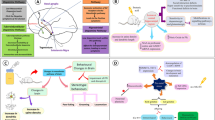Abstract—
The results of modeling intoxication in rats using lead acetate against the background of metabolic changes in the body and prenatal stress are presented. The motor activity and cognitive abilities, serum total cholesterol and lipid fractions, and bioelectric activity of the brain have been identified by testing the animals. It was found that intoxication with lead acetate against hyperglycemia or hyperlipidemia compared with the individual effects of lead acetate resulted in impaired cognitive abilities of animals and pronounced atherogenic changes, which included an increase in the concentrations of low-density lipoprotein cholesterol, triglycerides, and an atherogenic coefficient. It was recorded that lead intoxication complicated by metabolic disorders caused more prominent pathological changes in ECG parameters, such as tachycardia and a change in the duration of intraventricular conduction.
Similar content being viewed by others
REFERENCES
Badalyan, B.Yu., Sarksyan, Dzh.S., Khudaverdyan, A.D., Ambartsumyan, G.R., Saroyan, M.Yu., and Khudaverdyan, D.N., Prenatal stress as a factor of morphofunctional CNS disorders in prenatal and postnatal ontogenesis, Vopr. Teor. Klin. Med. (Yerevan), 2012, vol. 15, no. 3, pp. 7–20.
Demidova, T.Yu. and Galieva, O.R., Hypothyroidism, obesity, and coronary heart disease, Ozhir. Metab., 2007, no. 2, pp. 9–13.
Dong, Y., Yu, Z., Sun, Y., Zhou, H., Stites, J., Newell, K., and Weiner, C.P., Chronic fetal hypoxia produces selective brain injury associated with altered nitric oxide synthases, Amer. J. Obstet. Gynecol., 2011, vol. 204, no. 3, pp. 254–259.
Gomez, R., Huber, J., Tombini, G., and Barros, H.M.T., Acute effect of different antidepressants on glycemia in diabetic and non-diabetic rats, Braz. J. Med. Biol. Res., 2001, vol. 34, no. 1, pp. 57–64.
Gunn, A.J. and Bennet, L., Fetal hypoxia insults and patterns of brain injury: insights from animal models, Clin. Perinatol., 2009, vol. 36, no. 3, pp. 579–593.
Khotimchenko, M.Yu. and Kolenchenko, E.A., Efficiency of low-esterified pectin in the toxic liver damage caused by the lead introduction, Byull. Eksp. Biol. Med., 2007, vol. 144, no. 7, pp. 65–68.
Kovtun, O.P. and Tsyv’yan, P.B., Perinatal programming of hypertension in the child, Vestn. Ross. Akad. Med. Nauk, 2013, no. 6, pp. 34–38.
Küçük, M., Kalayci, R.B., and Çevik, A., Effect of aluminum on the blood–brain barrier permeability in acute and chronically hyperglycemic rats, Biol. Trace Element. Res., 2001, vol. 80, pp. 181–189.
Kudaeva, I.V. and Rukavishnikov, V.S., Pathogenetic aspects of occupational lipid metabolism disorders in persons working under chemical load, Med. Truda Prom. Ekol., 2014, no. 4, pp. 13–19.
Kudaeva, I.V., Masnavieva, L.B., and Budarina, L.A., Characteristics and patterns of disturbances of biochemical processes at work under exposure to various toxicants, Ekol. Chel., 2011, no. 1, pp. 3–10.
Kuz’mina, O.Yu. and Lotkov, B.C., Clinical and epidemiological features of the metabolic syndrome in patients with occupational diseases, Med. Truda Prom. Ekol., 2009, no. 10, pp. 1–6.
Lakka, H.M., Laaksonen, D.E., Lakka, T.A., Niskanen, L.K., Kumpusalo, E., Tuomilehto, J., and Salonen, J.T., The metabolic syndrome and total and cardiovascular disease mortality in middle-aged men, JAMA, 2002, vol. 288, pp. 2709–2716.
Lillycrop, K.A., Phillips, E.S., and Jackson, A.A., Dietary protein restriction of pregnant rats induces and folic acid supplementation prevents epigenetic modification of hepatic gene expression in the offspring, J. Nutr., 2005, vol. 135, pp. 1382–1386.
Makolkin, V.I., Metabolicheskii sindrom (Metabolic Syndrome), Moscow: Med. Inform. Agentstvo, 2010.
Mao, C., Hou, J., Ge, J., Hu, Y., Ding, Y., and Zhou, Y., Changes of renal AT1/AT2 receptors and structures in ovine fetuses following exposure to long-term hypoxia, Am. J. Nephrol., 2010, vol. 31, no. 2, pp. 141–150.
Martin, M., Rukovodstvo po elektrokardiografii melkikh domashnikh zhivotnykh (A Guide to Electrocardiography of Small Domestic Animals), Moscow: Akvarium, 2014.
Nesterenko, T.H. and Aly, H., Fetal and neonatal programming: evidence and clinical implications, J. Perinat., 2009, vol. 26, no. 3, pp. 191–198.
Novakovich, B. and Popovic, M., Occurrence of the metabolic syndrome in the population of the town of Novi Sad, Med. Pregl., 2001, vol. 54, pp. 17–20.
Prokopenko, L.V. and Sokolova, L.A., Measures to further improve the organizational forms of work with the use of experimental animals. Order of the USSR Ministry of Health from August 12, 1977, no. 755.6, Med. Truda Prom. Ekol., 2009, no. 12, pp. 5–10.
Revich, B.A., The features of ecological and epidemiological study of specific environment-related changes in the population health status, Gig. Sanit., 2001, no. 5, pp. 49–53.
Shprakh, V.V., Sayutina, S.V., Romazina, T.A., and Mikhalevich, I.M., Forecasting the development of cognitive disorders in patients with combined atherosclerosis of cerebral and coronary arteries, Sib. Med. Zh., 2011, no. 6 (105), рр. 57–59.
Turlybekova, G.K. and Zhuzbaeva, G.O., Lipid metabolism characteristics in the rat liver under chronic exposure to lead acetate and alimentary correction with Ecosorb AZhK-1, Vestn. Karagand. Gos. Univ., Ser. Biol. Med. Geogr., Karaganda: Kar. Gos. Univ., 2014, no. 2 (74), pp. 25–29.
Yakimova, N.L., Sosedova, L.M., Vokina, V.A., Titov, E.A., and Novikov, M.A., Manifestations of lead intoxication on the background of hyperglycemic condition in the experiment, Med. Truda Prom. Ekol., 2017, no. 2, pp. 54–56.
Author information
Authors and Affiliations
Corresponding author
Ethics declarations
Conflict of interests. The authors declare that they have no conflict of interest.
Statement on the welfare of animals. All experiments were conducted in accordance with the European Convention for the Protection of Vertebrate Animals Used for Experimental and Other Scientific Purposes (Strasburg, 1986) and Good Laboratory Practice (order of the Ministry of Health and Social Development of the Russian Federation no. 708n, August 23, 2010). Experiments were approved by a Local Ethical Committee (protocol no. 5, November 14, 2012).
Additional information
Translated by E. Sherstyuk
Rights and permissions
About this article
Cite this article
Sosedova, L.M., Yakimova, N.L. & Vokina, V.A. The Effect of Confounding Factors in Biomodeling of Intoxication. Biol Bull Russ Acad Sci 46, 608–614 (2019). https://doi.org/10.1134/S1062359019040149
Received:
Revised:
Accepted:
Published:
Issue Date:
DOI: https://doi.org/10.1134/S1062359019040149




